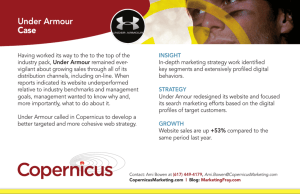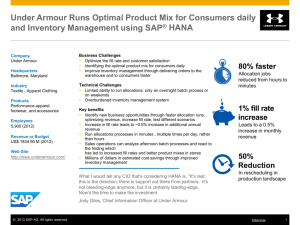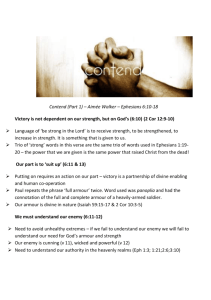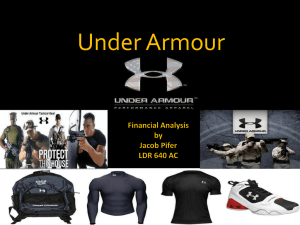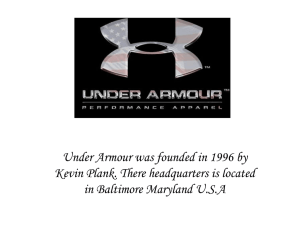Under Armour - Management Today Magazine
advertisement
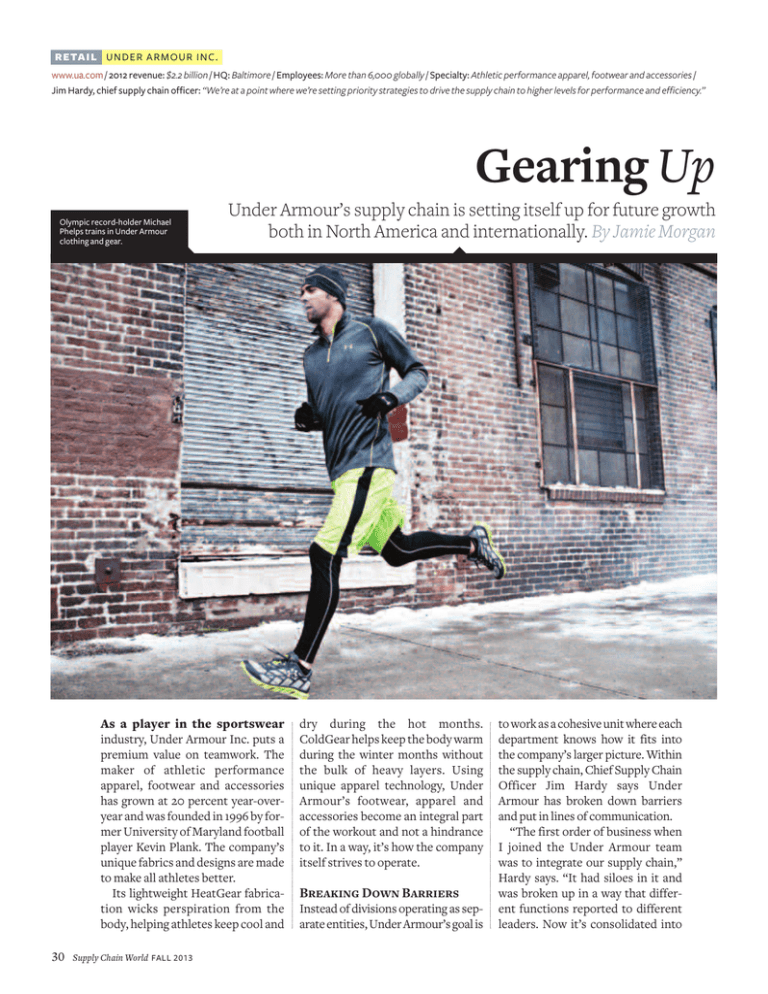
retail under armour inc. www.ua.com / 2012 revenue: $2.2 billion / HQ: Baltimore / Employees: More than 6,000 globally / Specialty: Athletic performance apparel, footwear and accessories / Jim Hardy, chief supply chain officer: “We’re at a point where we’re setting priority strategies to drive the supply chain to higher levels for performance and efficiency.” Gearing Up Olympic record-holder Michael Phelps trains in Under Armour clothing and gear. Under Armour’s supply chain is setting itself up for future growth both in North America and internationally. By Jamie Morgan As a player in the sportswear industry, Under Armour Inc. puts a premium value on teamwork. The maker of athletic performance apparel, footwear and accessories has grown at 20 percent year-overyear and was founded in 1996 by former University of Maryland football player Kevin Plank. The company’s unique fabrics and designs are made to make all athletes better. Its lightweight HeatGear fabrication wicks perspiration from the body, helping athletes keep cool and 30 Supply Chain World FALL 2013 dry during the hot months. ColdGear helps keep the body warm during the winter months without the bulk of heavy layers. Using unique apparel technology, Under Armour’s footwear, apparel and accessories become an integral part of the workout and not a hindrance to it. In a way, it’s how the company itself strives to operate. Breaking Down Barriers Instead of divisions operating as separate entities, Under Armour’s goal is to work as a cohesive unit where each department knows how it fits into the company’s larger picture. Within the supply chain, Chief Supply Chain Officer Jim Hardy says Under Armour has broken down barriers and put in lines of communication. “The first order of business when I joined the Under Armour team was to integrate our supply chain,” Hardy says. “It had siloes in it and was broken up in a way that different functions reported to different leaders. Now it’s consolidated into under armour inc. retail Winter Olympic gold medalist Lindsey Vonn models Under Armour ColdGear. one leader and we are able to drive more integration into the supply chain. We made improvements to operate as one team with a common scorecard and common metrics. Now we’re at the point where we’re setting priority strategies to drive the supply chain to higher levels for performance and efficiency.” Under Armour’s supply chain, which is housed in Baltimore, including two distribution centers – one in Baltimore and another in Rialto, Calif. – began holding monthly accountability meetings. The conversations have resulted in each team member gaining a complete picture of how Under Armour’s supply chain works. Instead of seeing a portion of the supply chain, teammates can now see how their actions affect or are affected by another portion of the supply chain. It’s also given the team the ability to apply metrics and begin tracking performance against a set scorecard. “We are beginning to understand the implications of one metric in an area like planning and how that metric plays out in terms of efficiency and effectiveness downstream to sourcing,” says Hardy, who has been with the company for 16 months. “We’re finding touch points where we can pinpoint key metrics that can predict success downstream in the supply chain. We are now able to anticipate business needs and as a result we can see problems faster and sooner allowing us time to react.” The company has people and processes in place to support these metrics and it’s also investing in technology that aligns with its new business model. Under Armour implemented Logility software to organize its planning system. The company has gone live with the software to support downstream func- tions such as manufacturing scheduling. In September the company will go live with Logility software to support upstream planning functions such as demand forecasts. The company is also looking to up its game in the metrics field. Hardy says the company is beginning to benefit from its first set of metrics and now it’s looking at tier 2 metrics that will allow the company to “be more predictive and give us more headlights as we look into the future.” Wen-Parker Logistics (WPL) is a solutions-driven global logistics organization providing a comprehensive menu of endto-end supply chain services to retail clients like Under Armour (UA) and many other well-known brands across a broad range of different industries and vertical market segments. Year after year since 2009 the UA - WPL business partnership has consistently grown and continues to reach new heights in conjunction with Under Armour’s ever-expanding global growth and international market penetration. Recognized by Under Armour as its “International Logistics Provider of the Year” for both 2011 and 2012, WPL’s global business partnership with UA, which now spans 5 continents, goes well beyond basic air and ocean freight forwarding to include value-driven supply chain solutions such as multi-country consolidation and warehousing and distribution services in Asia that help increase critical speed to market and optimize cost and overall supply chain efficiency. For more information on Wen-Parker Logistics contact info@wen-parker.com or visit www.wen-parker.com. FALL 2013 Supply Chain World 31 retail under armour inc. Welterweight Champion of the UFC Georges St-Pierre wears Alter Ego, Under Armour’s latest collection with DC Comics and Marvel Entertainment. “The biggest trend we’re seeing is that consumers are really responding to innovation and to new ideas and concepts.” ________ Supply Chain of Events The new measures aren’t just good for Under Armour, but for its strategic partners, as well. The changes in Under Armour’s supply chain allows the company to give 12- to 18-month forecasts to third-party manufacturers who handle all of Under Armour’s production. About 70 percent of its production is sourced from strategic long-term partners. The company meets with these part34 Supply Chain World FALL 2013 ners once a month to go over scorecards, discuss performance and talk about Under Armour’s market performance and projected sales. Hardy says meeting face-to-face allows Under Armour and its partners to develop a shared strategy. As the company shares its growth projections with key suppliers, those suppliers can prepare for the future and invest in additional capacity if needed. The communication creates a trickle-down effect that has helped Under Armour lower replenishment lead times by 30 percent. “It’s allowing us to see past the constraints of third-party manufacturing much sooner,” he says. “It’s allowing us to give forecasts and look forward to start planning capacity and demand changes. We are a 20 percent growth company so it’s important for us to give suppliers visibility into the growth we anticipate. And it’s allowing us to start making some very educated commitments on things like fabric much earlier, which allows our supply chain to be more nimble. “We can go to mills and produce fabric in advance, which allows our cut-and-sew manufacturers to be faster because they don’t have to wait on fabric,” Hardy continues. “It takes time out of the lead time so we can go to market faster.” RCS Logistics supports Under Armour’s supply chain by providing air freight services globally. As the apparel/retail market leader in providing air freight supply chain solutions, RCS Logistics is proud to support Under Armour’s global supply chain initiatives towards speed to market. retail under armour inc. Which is a good thing, because as Hardy explains, the market is hungry for new products. The Under Armour brand was born out of innovation. It took the idea of a simple t-shirt and designed a product to wick sweat away from the body, support muscles and keep athletes cool and dry. Now 17 years later, Under Armour has an array of athletic apparel. Alter Ego, one of its recently launched lines, features Under Armour compression t-shirts and football gloves with a superhero spin. Hardy says the Superman-, Batman-, Iron Man- and Spiderman-inspired gear has been a hit. “The biggest trend we’re seeing is that consumers are really responding to innovation and to new ideas and concepts so we’re 36 Supply Chain World FALL 2013 finding that when we come out with new things, the demand is there for those products,” Hardy says. “We took our base layer, which is a core product and we launched Alter Ego. It’s leveraging the popularity of these Marvel and DC comic characters and integrating it into our core item. We are seeing sales go up dramatically.” International Push The company’s newest focus is to drive that innovation into new markets. Under Armour’s revenue stands at 94 percent North American sales and 6 percent global sales. Under Armour aims to double global sales by 2016. Hardy explains the company is working with SAP to design an enterprise resource planning roadmap to grow in new markets. “We’re using a SAP product called Business One that will allow us to conduct business much faster,” Hardy says. “We are now in the process of blueprinting and getting the playbook set up for IT implementation to go live later this year. As a growth company, our goal is for our international sales to one day surpass our North American sales.” Intelligrated® (www.intelligrated.com) designs, manufactures and installs complete material handling automation solutions, including conveyor systems, IntelliSort® sortation systems, Alvey® palletizers and robotics, Real Time Solutions® order fulfillment systems, warehouse control software and advanced machine controls—supported by 24X7 Customer Service and Support. Through its subsidiary, Knighted® (www.knightedcs.com), Intelligrated offers webenabled logistics software for today’s supply chain operations including warehouse management software (WMS), warehouse control software (WCS) and labor management software (LMS).
